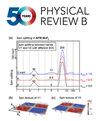磁跳跃引起的三维拓扑轨道霍尔效应
IF 3.7
2区 物理与天体物理
Q1 Physics and Astronomy
引用次数: 0
摘要
磁霍普子是一种非线性共线自旋织构,其特征是一个整数拓扑不变量,称为霍普夫指数。三维磁孤子可以被认为是一根两端闭合形成环面的磁化扭曲的管子。该管由一个称为面内粒子或双粒子的磁旋组成。尽管人们已经通过显微镜技术观察到了hoppons,但由于迄今为止它们缺乏电子标志,因此检测它们仍然具有挑战性。本文预测了由跳子纹理引起的三维轨道霍尔效应:当施加电场时,跳子产生轨道角动量的横向电流。这种效应的产生是由于局部涌现场产生了面内和面外的轨道霍尔电导率。这种轨道霍尔响应可以被视为hopfions的标志,并使我们能够将它们与其他纹理区分开来,例如在真实空间显微镜实验中看起来相似的skyrmionium。一个粒子的二维拓扑不变量决定了它的拓扑霍尔输运,而独特的三维拓扑轨道霍尔效应可以用三维拓扑不变量Hopf指数来识别。我们的研究结果使hopons对自旋轨道应用具有吸引力,因为它们的轨道特征允许在设备中检测它们并产生大的轨道扭矩。本文章由计算机程序翻译,如有差异,请以英文原文为准。
Three-dimensional topological orbital Hall effect caused by magnetic hopfions
Magnetic hopfions are noncollinear spin textures that are characterized by an integer topological invariant, called the Hopf index. The three-dimensional magnetic solitons can be thought of as a tube with a twisted magnetization that has been closed at both ends to form a torus. The tube consists of a magnetic whirl called an in-plane skyrmion or bimeron. Although hopfions have been observed by microscopy techniques, their detection remains challenging as they lack an electronic hallmark so far. Here we predict a three-dimensional orbital Hall effect caused by hopfion textures: When an electric field is applied, the hopfion generates a transverse current of orbital angular momentum. The effect arises due to the local emergent field that gives rise to in-plane and out-of-plane orbital Hall conductivities. This orbital Hall response can be seen as a hallmark of hopfions and allows us to distinguish them from other textures, such as skyrmioniums, that look similar in real-space microscopy experiments. While the two-dimensional topological invariant of a skyrmion determines its topological Hall transport, the unique three-dimensional topological orbital Hall effect can be identified with the three-dimensional topological invariant that is the Hopf index. Our results make hopfions attractive for spin-orbitronic applications because their orbital signatures allow for their detection in devices and give rise to large orbital torques.
求助全文
通过发布文献求助,成功后即可免费获取论文全文。
去求助
来源期刊

Physical Review B
物理-物理:凝聚态物理
CiteScore
6.70
自引率
32.40%
发文量
0
审稿时长
3.0 months
期刊介绍:
Physical Review B (PRB) is the world’s largest dedicated physics journal, publishing approximately 100 new, high-quality papers each week. The most highly cited journal in condensed matter physics, PRB provides outstanding depth and breadth of coverage, combined with unrivaled context and background for ongoing research by scientists worldwide.
PRB covers the full range of condensed matter, materials physics, and related subfields, including:
-Structure and phase transitions
-Ferroelectrics and multiferroics
-Disordered systems and alloys
-Magnetism
-Superconductivity
-Electronic structure, photonics, and metamaterials
-Semiconductors and mesoscopic systems
-Surfaces, nanoscience, and two-dimensional materials
-Topological states of matter
 求助内容:
求助内容: 应助结果提醒方式:
应助结果提醒方式:


